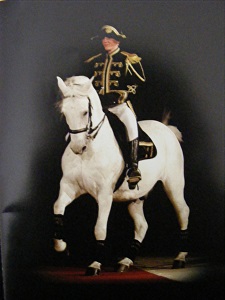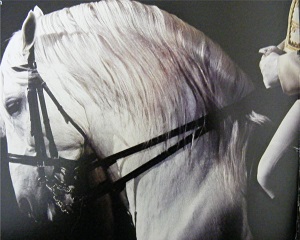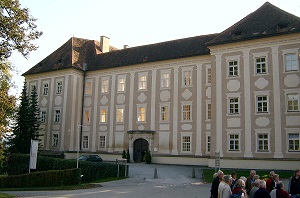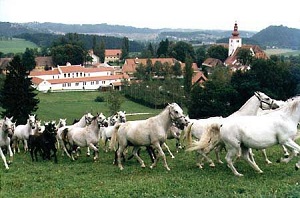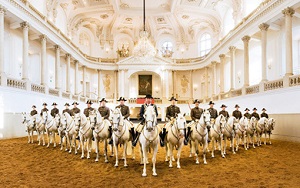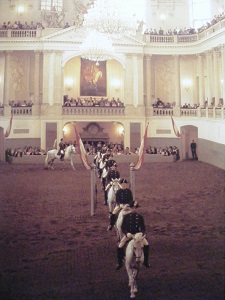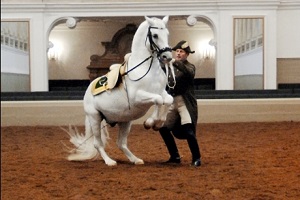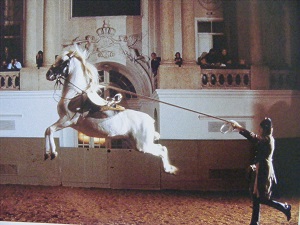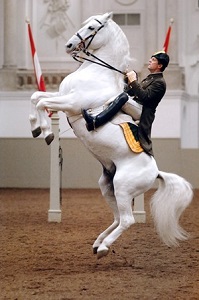Favourites on Friday - Dancing White Horses
“Thou must learn the thoughts of the noble horse whom thou wouldst ride. Be not indiscreet in the demands, nor requiring him to perform indiscreetly. The horse is a wise animal. Let him show you the best and most natural way to accomplish a desired end.” ~ Johann Wolfgang Goethe
Back in 2003, I was lucky enough to see a performance by the Lipizzaner Stallions right here in Bournemouth. I took the boys and a friend’s horse-mad daughter; they can still remember the beautiful horses. Came across the programme during a rare moment of tidying – time for a post.
Modern dressage, as horsey-people know, was initially developed for the cavalry, and dates back to 400BC Greece when the cavalry officer, historian and disciple of Socrates, Xenophon, wrote the classic work on the art of training horses, ‘On Horsemanship’. He developed the idea of training horses by teaching the horse to trust humans, and encouraging the horse to enjoy itself, or the training would have very little value.
Xenophon
“ The gods have given man the ability to teach a sense of duty to his peers through the spoken word, but it is clear that the horse cannot be taught anything through the spoken word.”
“ For what the horse does under compulsion … is done without understanding; and there is no beauty in it either, any more than if one should whip and spur a dancer. There would be a great deal more ungracefulness than beauty in either a horse or a man that was so treated. No, he should show off all his finest and most brilliant performances willingly and at a mere sign.”
“ If one induces the horse to assume that carriage, which it would adopt of its own accord when displaying its beauty, then one directs the horse to appear joyous and magnificent, proud and remarkable for having been ridden.”
Xenophon’s approach declined under the Roman Empire, and, especially, during the Middle Ages with the advent of the heavily armoured knight. Encased in suits of armour, riding heavier horses, their only goal to unseat their opponent with a lance, these horsemen had no use for manoeuvrability, flexibility, or the need for subtle communication with their horses. The higher positions that their saddles afforded, and the use of heavy gloves or gauntlets to hold the reins, put the knights in the position of barely feeling any contact with the horse – hardly conducive to fine riding. However, dressage was still used by mounted bowmen; as they did not wear heavy armour, they could rely more on the agility of their horses to enhance their archery skills.
In the 16th century, during the Renaissance, the art of classical riding was revived in Europe, mainly due to the legendary skill of Spanish cavaliers. The knight had had his day, and the military now required lighter, faster horses for the cavalry.
The dressage skills that the competitive horse gracefully performs today was used to deadly effect to enable the horse to twist out of the way of a sabre, to form up for a lethal cavalry charge, or to execute a quick circle and gallop back the way it had come, especially if its rider was injured.

'Charge of the Light Brigade' ~ Caton Woodville
The Hapsburg family controlled both Spain and Austria; inspired by the delicacy and obedience of the Andalusian, it was easy enough to bring the Spanish horse to Austria. Emperor Maximillian II did this in 1562 and founded the court stud at Kladrub. In 1580, his brother, Archduke Charles II established a royal stud farm in the small village of Lipizza (in modern-day Slovenia). Spanish, Barb and Arabian stock were crossed with other breeds to produce the Lipizzan.
During the First World War, the stallions, brood mares and foals were evacuated from Lipizza, and relocated to Laxenburg, near Vienna, and Kladrub. After the war, the Austro-Hungarian Empire was divided, along with the possessions of the former monarchy; this included the breeding stock of the imperial stud farm of Lipizza. The village of Lipizza was awarded to Italy, while the foals at Kladrub became the possessions of the Czechoslovakian state. In 1919, Austria, now a republic, was granted the rest of the breeding stock and the stallions of the Spanish Riding School. Now, the Lipizzan homeland in Vienna is the Stud Piber, in the Austrian province of Styria.
Piber Castle (Karl Gruber) and Stud Piber
During the Second World War, the Lipizzan breed again faced extinction … But I will cover that in another post.
The Lipizzan is genetically a type of grey. Foals are born with a black-brown, brown, or grey coat, which gradually lighten until their legendary white coat emerges, usually between the ages of 6 and 10. Not a tall horse, the Lipizzan is known for its sturdy body and proud carriage, large eyes and small ears. Its crested neck, powerful shoulders and strong legs are ideally suited to display the elegance of classical horsemanship.
Named after the Spanish horses that were imported in the 16th century, the Spanish Riding School in Vienna is the oldest institute where the classic art of riding is still practised today in its purest form.
The riders’ understated, elegant uniform of coffee brown tailcoats, white pants, white gloves, and black boots complement the horses, without distracting from the performance.

This is definitely on my 'to-do' list - a visit to Vienna, and to the Spanish Riding School to see these beautiful, elegant yet powerful horses for myself.

